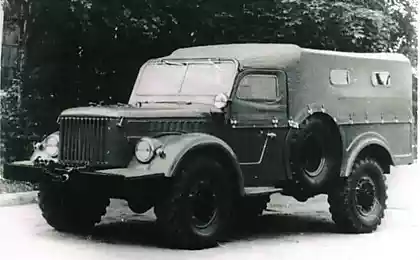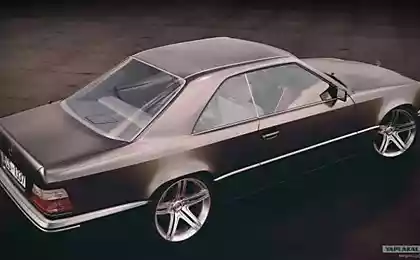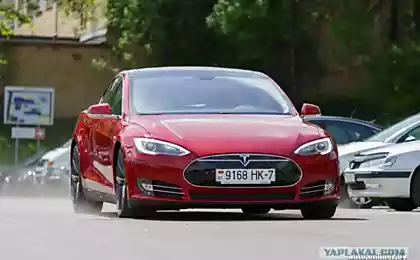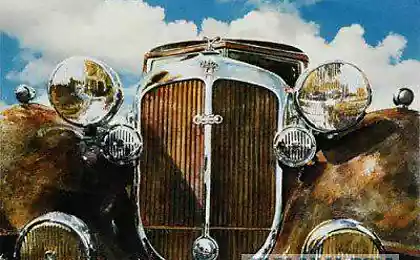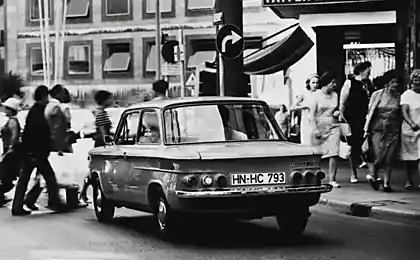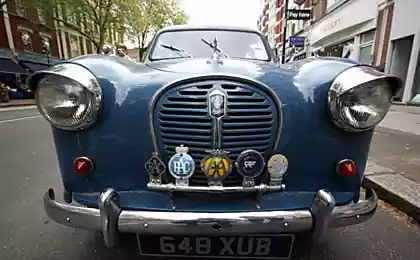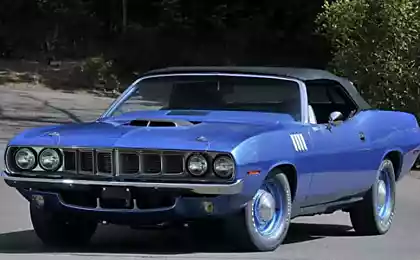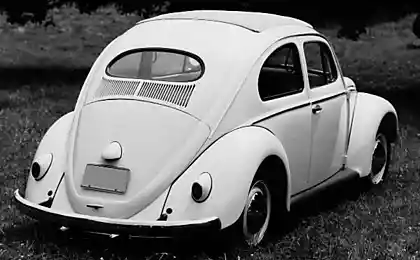1195
The last car Trabant.
April 30, 1991 from the factory gate VEB Sachsenring Zwickau in the German drove the last car Trabant. For the whole world this event became a symbol of the final defeat of the socialist regime in Germany and throughout Eastern Europe. If you omit the political subtext, then 20 years ago I ended career of one of the most interesting cars of the last century. In my lifetime seen any grit Trabant: the burden of popularity and unfounded accusations, and even fierce hatred.
26 photos + text
Photo 1.
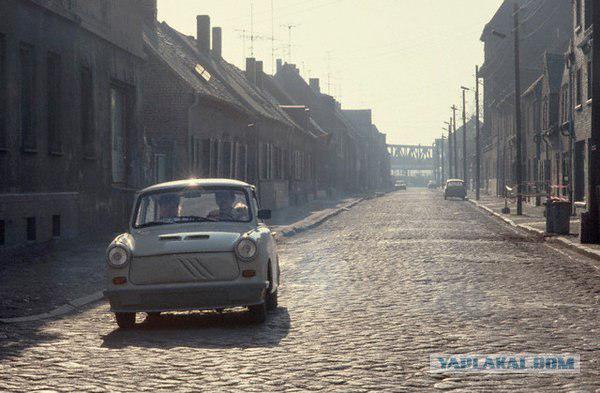
His appearance Trabant owes miscalculation of US military strategists. The Yankees had hoped that the industrial town of Zwickau, known for rich coal deposits, as well as automobile companies Audi and Horch, after the partition of Germany, will get Western allies. That's why, to bulldoze the same Dresden, American bombers spared Zwickau. However, as it turned out, this little dot on the map is valuable for the Soviet Union, with the result that Zwickau was in the Soviet occupation zone. Soon the former factory Audi, which became part of the state of engineering conglomerate IFA (Industrieverband Fahrzeugbau, or, more simply, Industrial Association to create a car), resumed production of cars.
2. Elegant Photo IFA F9 accounts Trabant grandfather
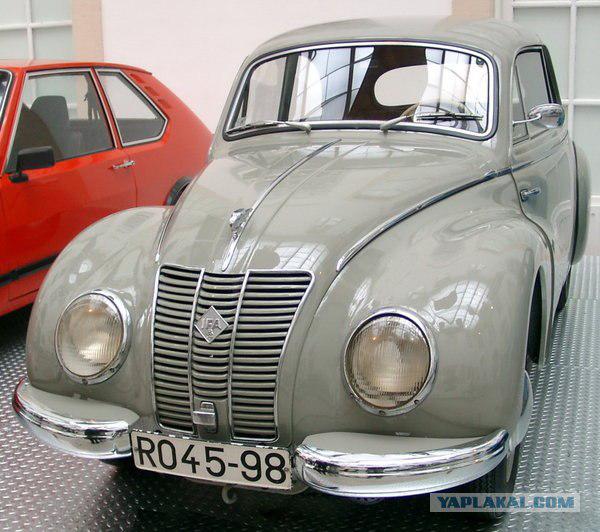
However, IFA F8, presented at the trade fair in Leipzig in 1948, was a copy of the pre-war DKW F8. Okay machine with a two-stroke engine with liquid cooling in any case could not be called outdated. But the "eight", as in the following models followed F9, there were deficiencies of a different order. The fact is that its production required a metal. A lot of metal. While the GDR experienced a shortage of rolling sheet, as traditional suppliers of iron ore are outside the country: in Poland and West Germany. In turn, the rich natural resources of the USSR barely had time to pursue their own demand for the metal. So what the best minds of the German Democratic Republic began to hastily find a replacement.
Photo 3. Sachsenring P70 (pictured version with a very impressive coupé) became the first car body is entirely made of "duroplastic".
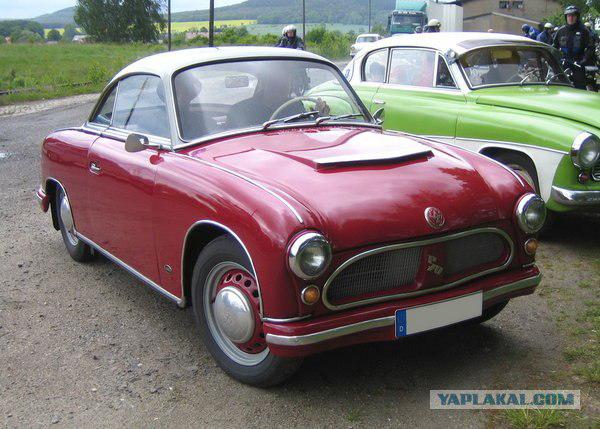
And soon, the local chemical industry has found an answer. It turned out that as a result of thermal treatment of carbolic acid (phenol), mixed with a hardener in the form of textile scraps, turning into a cheap, lightweight and extremely durable plastic. Moreover, the material was named "Duroplastic" (from the Latin Dura - Hardy), unlike the fiberglass, you can give the necessary form by stamping press.
Photo 4. The first prototype of the future Trabant, created in 1954, can be seen in the museum August Horch
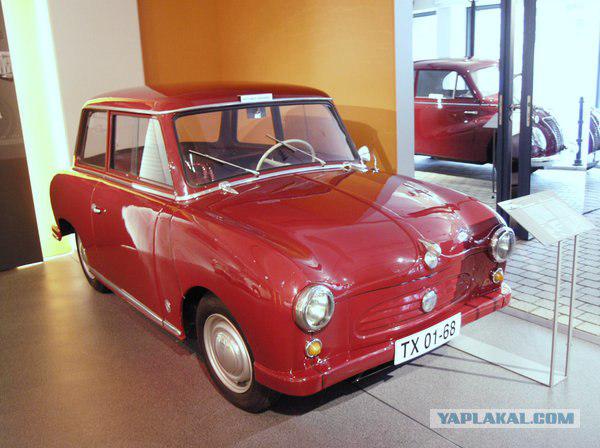
For the first time, "duroplastovye" panel on the hood were later copies IFA F8. In Zwickau we were satisfied with the experiment, and the following model was originally developed for "duroplastovoy" technology.
Photo 5. Serial Trabant P50 compared to the prototype slightly increased in size
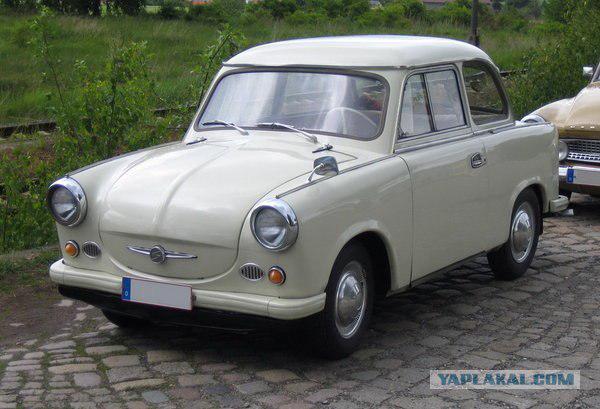
Debuted in 1955 Sachsenring P70 (Car Factory christened in honor of a nearby race track) was a quite elegant and very modern at the time, "duroplastovy" box, put on the frame of the same IFA F8. 700-cc 22-strong "semidesyatku" is available in three versions: sedan, wagon and even a very nice coupe, but production soon turned. In just four years released a little more than 36 thousand copies of the P70 (by the way, the letter P in the index is not Plastic, as might be expected, but Personen, I mean the "passenger"). Firstly, for the average citizen of East Germany, the machine was too smart and too powerful, but more importantly, it was conceived with a specific purpose - to experience "duroplastovuyu" technology on the scale of mass production. Now, did their job, P70 had to give way to a truly national car.
Photo 6. Trabant station wagon introduced in January 1960. Comfortable and cute Kombi cost almost 1,500 brands more expensive sedan.
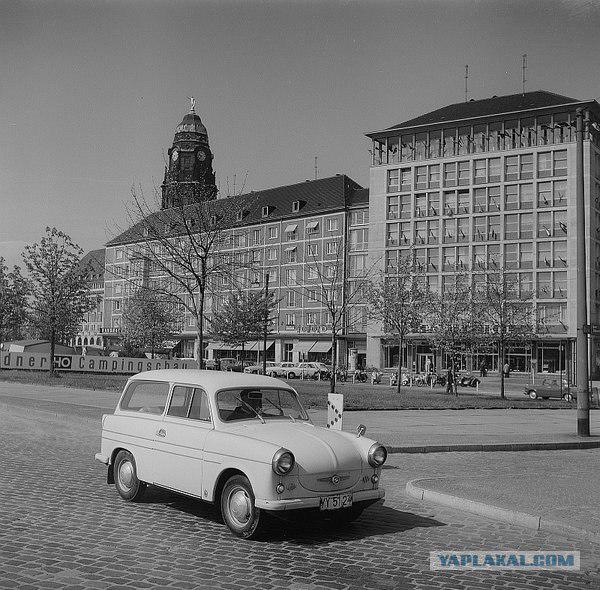
Development of the model, which went down in history as the Trabant, began in the early 50s. Evil tongues say that the original German designers have created three-wheeled microcar that is only by chance into a car. But that's what this through the newspaper "The economy in the automotive industry" - organ of the automotive industry of the GDR, "small-car design does not imply primitiveness. As a means of transportation for the workers and employees, such machines must have adequate driving characteristics and a reasonable degree of comfort ».
Picture 7. Picture from a comfortable distance. Dresden Station early 60s. In the foreground, Trabant P50, wormed his way into the company of three "Moskvich», Skoda and nowhere grafted Renault 4CV
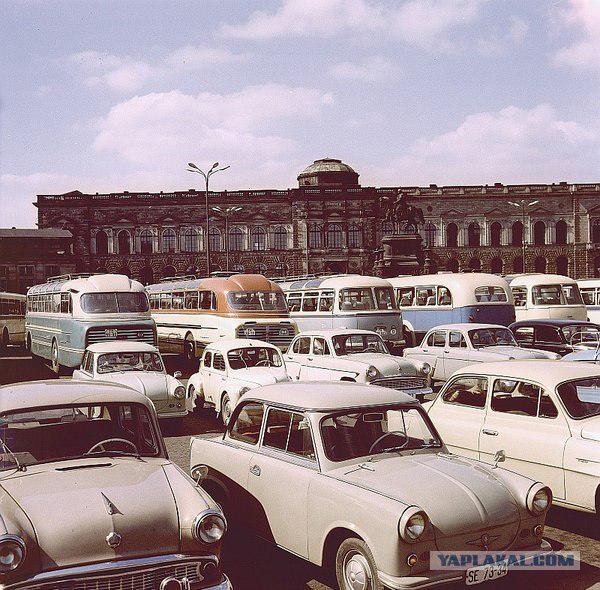
Further, in some detail in the paper outlining the new gostrebovaniya mass car "two-cylinder, two-stroke gasoline engine is air-cooled cylinder capacity of 400-500 cm3 and a power of 14-20 hp Plastic body. The estimated maximum speed of 85 km / h ... »
Picture 8. Cross-section Trabant demonstrates quite spacious interior
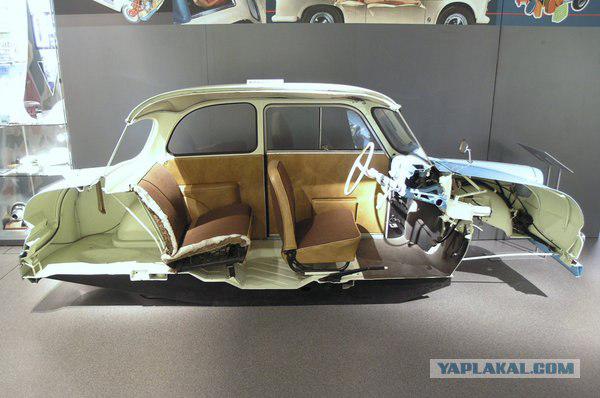
The first rideable prototype model P50 - three sedan and wagon - gathered in June of 1954. Compared with "semidesyatkoy" novelty became even more compact - the wheelbase slightly more than 2 meters, the overall length of 3, 3 m, but the main thing - under the hood was prescribed another engine. VEB Barkas engine plant from Karl-Marx-Stadt on the basis of pre-war DKW motorcycle engine developed 500 cc two-stroke, air-cooled capacity of 17 liters. from. Few, of course. On the other hand, due to the body panels of the "duroplastic" the car it was very easy. Imagine the roof, hood, front panel, trunk lid, a pair of doors and four wings weighed only 32 kg! The curb weight of the sedan did not exceed 600 kg, even with very modest means allow the motor to accelerate to 90 km / h.
Photo 9. Since the 1959 P50 can be ordered with two-tone paint finishes
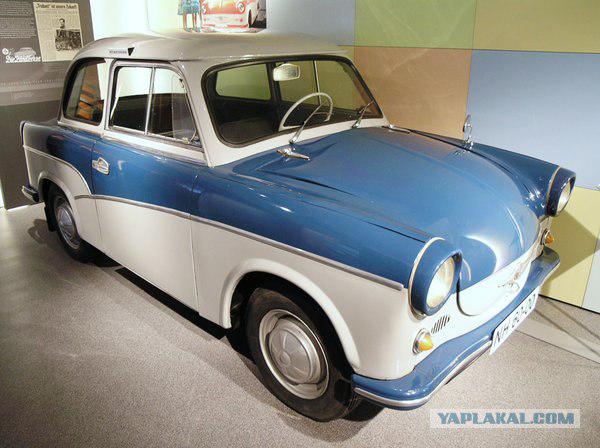
Plastic body - not only the dignity of the East German minicar. Generally, for the time P50, contrary to popular belief, it was a very advanced design. Suffice it to mention the front-wheel drive layout with a transverse engine, independent suspension on all four wheels, steering rack and pinion type.
Picture 10. Trabant-wagon and today looks charming and cute
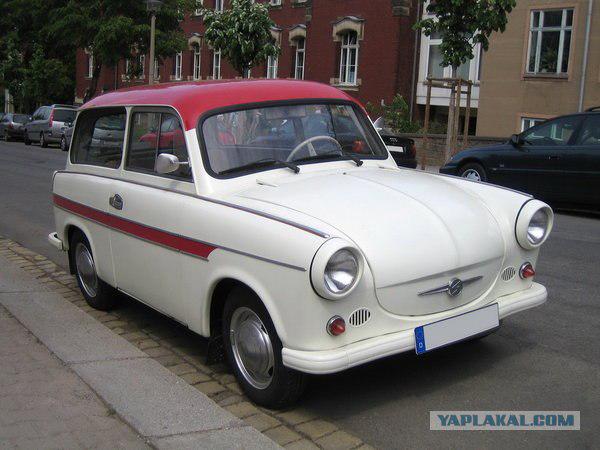
But the name of the "duroplastovogo" baby came a little later - only in 1957. After November 7 - just in time for the 40th anniversary of the October Revolution - in Zwickau collected the first preproduction sample P50, the plant's management has announced a creative contest among employees of a better name. Some of the workers and offered Trabant - sonorous, easy to remember word means "companion", "good companion" or simply "companion." Considering that in October the same year, the first successful launch into space Sputnik, and the name came for ideological reasons.
Picture 11. restyled version of the Trabant P601 easy to identify on the redesigned headlights and grille "radiator".

Serial production Sachsenring Trabant P50 began in August of 1958, and a plastic "satellite" soon came to the court. And not only at home - the first time P50 actively and unsuccessfully offered in the markets of Western Europe. For its time, and, of course, its price Trabant seemed very profitable acquisition. With modest size - only 3 m 37 cm in length - it is a full four-seater with a very roomy trunk. Add to that modest consumption of gasoline - only 6 and 7 liters per hundred run - and understand why thousands of buyers from Western Europe to choose a car from the GDR. However, in the early '60s, when the market debuted new Austin Mini and Renault 4, P50 interest in the West began to rapidly decline.
Picture 12. Trabant P600, which debuted in 1962, was distinguished counterbore 600 cc engine and manual synchronized.
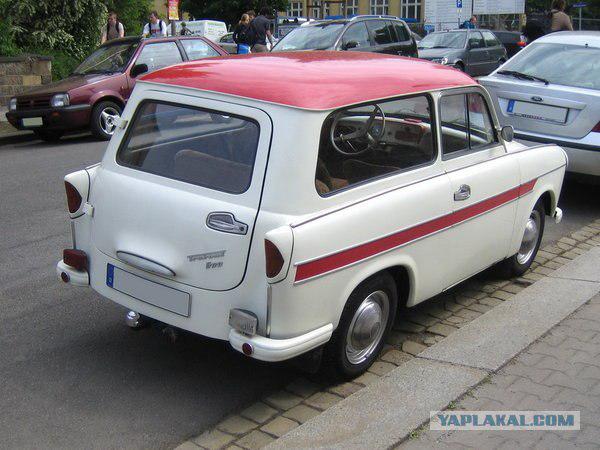
But the home of the Trabant lined terrible turn. If at first the waiting time of delivery is 18 months, soon it grew to three years. And this is not the limit. At the height of the popularity of the plastic line for "satellite" stretched the seemingly incredible 15 years today! That is why a used car easily marketed with it at a price significantly higher than the cost of new!
Photo 13. It's hard to believe, but the Trabant quite successfully raced in international rallies. On account of the baby, for example, second place in the famous Monte Carlo. In his class, of course)))
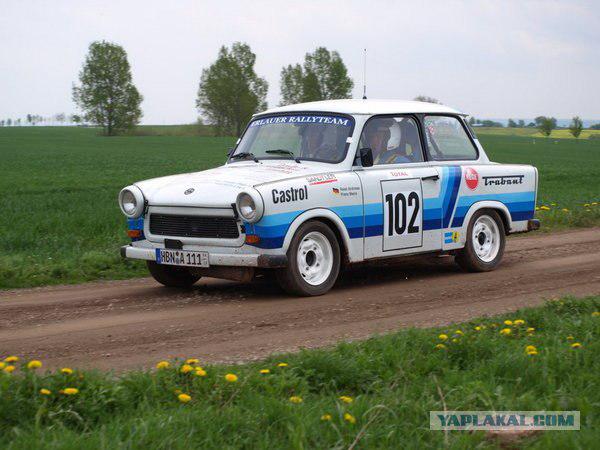
And because its output can not be called tiny - in the best years out of the gate of the plant in Zwickau leaving the country to 150 thousand sedans and station wagons. More national enterprise Sachsenring could do physically. The fact that the process of production of one "duroplastovoy" panel takes about 10 minutes - much slower metal stamps. Theoretically, it was possible to manufacture more stamping forms, but the planned economy of the GDR did not provide for such wastes. Yes, and the process of assembling a car can not be called the best, because it involved a minimum of four companies. Former factory Horch in Zwickau He produced the chassis, the engines were from the Karl-Marx-Stadt, and the final assembly was carried out on another automobile factory Zwickau, where before the war produced Audi. Finally, "duroplastovye" panel stamped on the nearby former textile factory.
Picture 14. Advertising brochure Dutch dealer Trabant.

So that customers had to wait patiently. And they waited. We waited for years. Of course, we can say that neizbalovannyh hard workers simply had no choice. But this is only partly true. As the opinion polls, 50% of car owners would buy again Trabant, even if you could choose any model offered by the automotive industry sotsbloka.
Photo 15. One of the many, but, alas, not born heirs - project P610.

What is the secret of such loyalty? Firstly, the price. For example, in 1976 the simplest Trabant GDR market was worth 7,170 marks. Not too small, considering that the average salary in the country was only 400 marks a month. But other cars were much more expensive. Exported from the Soviet Union ZAZ-968 was estimated at 12,000 for a four-Wartburg asked 16 800, and the most unassumingly "Lada" VAZ-2101 with 1, 2-liter engine just does not hold out up to 19 thousand! Do not forget that at that time the car was considered a luxury that most mortals could afford only once in a lifetime. If so, the reliability and durability of the car came out to the fore. And just for the vitality of the Trabant, perhaps, I had no equal.
Picture 16.
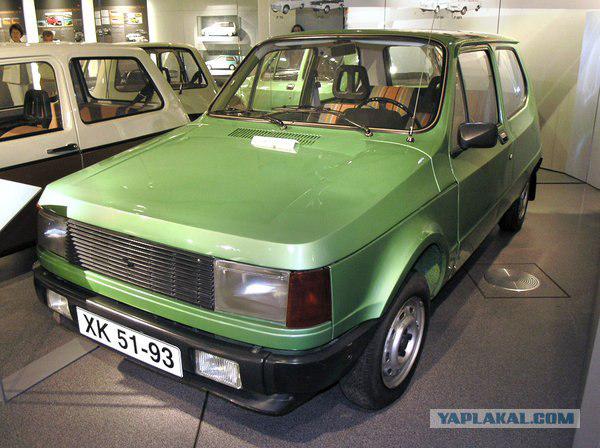
For example, 2-cylinder two-stroke engine was only five moving parts. There were no valves, no camshaft, no timing belt. Also absent from the oil pump - lubrication when filling a small amount of oil is added directly to the tank. Finally, air cooling helped get rid of the water pump. The simplicity of the design guarantee high reliability. In fact, and what is there to break something? However, even if the engine is still "catching the wedge", that did not mean the end of the world. Unscrewing the five screws and disconnect the hose with wires, light and compact motor once or twice removed from under the hood. It is not surprising that some of the owners drove in the trunk spare engine! Do not forget about the "duroplastovy" body, completely indifferent to corrosion. This is where the legs grow phenomenal longevity Trabant - according to statistics, the average life of the kid was 28 years old!
Picture 17. As can be clearly seen, two-stroke Trabant motor under the hood was very at ease.
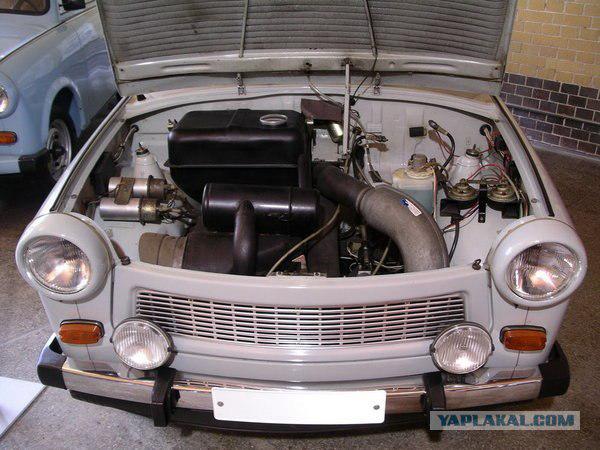
And of course, throughout the life of the design of the machine is constantly making various changes and improvements. So, in the fall of 1958, after only a few months after the debut, Trabant got slightly upgraded engine capacity of 18 liters. a., after a while there was a fully synchronized 4-speed gearbox and nice things like the heated rear window, folding seats, forming a bed, and two color options trehtonovye body. In October 62 th under the hood, a new 600 cc engine, which built 23 liters. s., and six months later at the Congress of the Communist Party of the GDR presented and restyled version - Trabant P601. It will become the most widespread version of the model, and no major changes live to 90.
Picture 18. For comparison, look at the amount of space required 1 4-cylinder, 1-liter engine from VW.
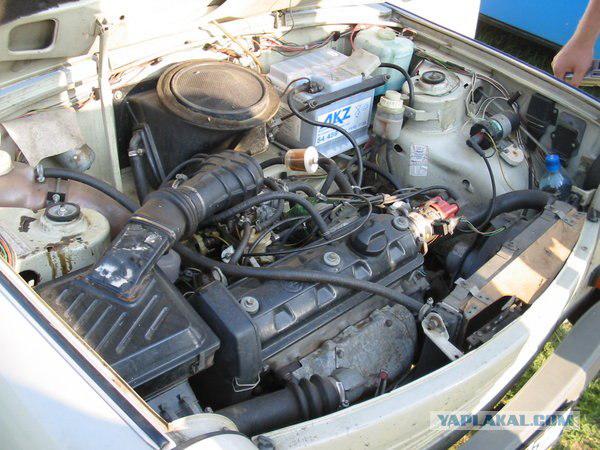
The funny thing is that initially the 601 th conceived transition model that no later than 1967 had to change the Trabant entirely new generation. But with the heirs' duroplastovomu "satellite decidedly unlucky.
Picture 19. For more than 30 years on the assembly line were produced 3,096,099 copies of the model.

Back in the early 60's in the office promising developments of the national enterprise created Sachsenring Trabant P602 hatchback. Alas, the project has not found a curious understanding of leadership. It turned out to be ruined and other promising minicar, although P603 had a good chance to become the sensation of the pan-European scale. Imagine a three-door hatchback with a light and strong body of "duroplastic" 4-seater interior and the latest 500 cc rotary-piston Wankel engine capacity of 55 liters. from. And that in 1968, four years before the debut of the Renault 5 and FIAT 126! However, the project was closed at the initiative of an influential member of the Politburo gedeereshnogo. Guenter Mittag, who was responsible for economic issues, found that a new car is easier to create the joint efforts of design offices Trabant, Wartburg and Skoda. For five and a half million marks invested in the development of P603, crumbled and from the joint Czech-German project as easy to guess, and nothing good happened.
Picture 20. Demonstrating the strength "duroplastic".
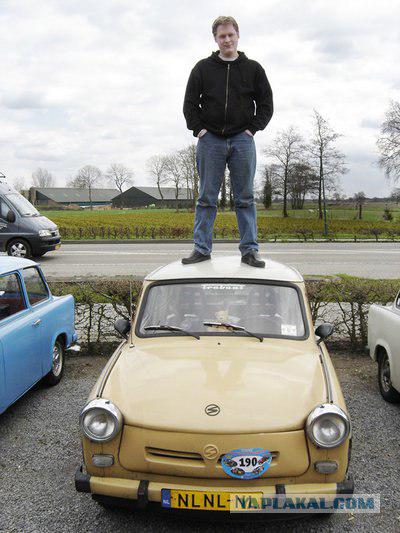
Enumerating the planned, but never born heirs Trabant, easy to lose count. Gone are the ambitious projects of compact hatch P610 and P760, museum exhibits were diesel variant and model P1100 - another hatchback with engine Skoda. As they say, the engineers suggest, and the party has. GDR leadership did not see serious justification for speeding up, and most importantly for financing the development of new models - after all, become obsolete in the eyes of the 601-th went off like hot cakes. So it was in the '60s and' 70s and '80s ...
Picture 21. Trabant 1, 1 is easily recognized by the characteristic pattern of the grille.
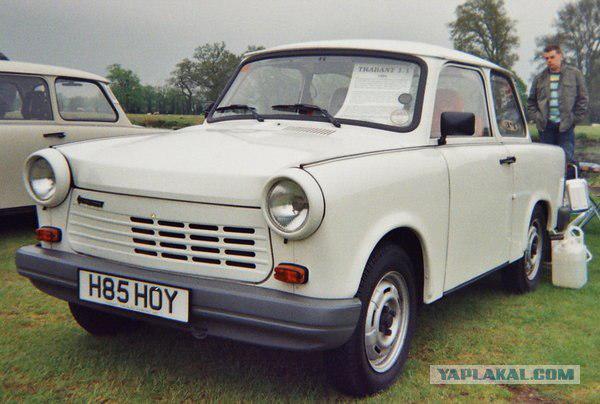
Last noteworthy episode in the biography of the model refers to 1989. When the relationship between East and West Germany became warmer, Trabant finally got a modern engine. 1, 1-liter, 45-horsepower, four-stroke, in-line "Four" from Volkswagen markedly improved as the dynamics - the maximum speed increased to 135 km / h - and the environmental performance. But it was too late.
Picture 22. A rare modification Trabant Tramp - socialist version of a beach buggy.
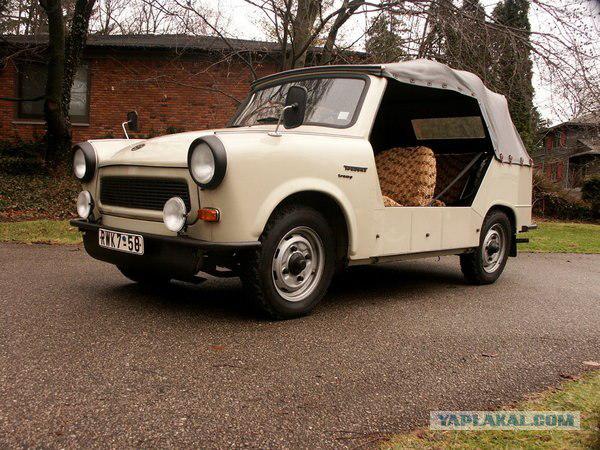
By the time the Trabant has become obsolete in uncomplaining scapegoat on which people are tired of the charms of socialism could painlessly and without all the consequences to unburden himself. What has not made the unfortunate "duroplastovym" avtomobilchikom! And assorted souvenirs and clowny Therefore painted, burned and thrown from a bridge. But even more painful for the car hit the word. At the end of his days "companion" I had to hear a lot about yourself any insulting nonsense.
Picture 23.
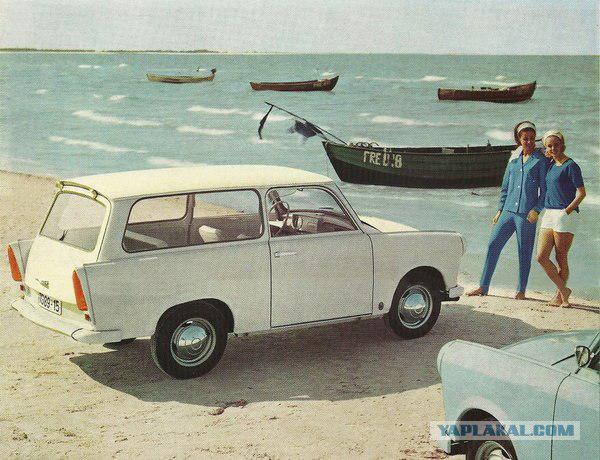
He remembers everything from the poisonous atmosphere of the two-stroke engine and a plastic body, which, according to the assertions of some "experts" did not leave the driver and passenger the chance of survival in a collision at a speed of only 40 km / h, up pathetic handling and "duroplastovyh" panels, see Do not recyclable.
Picture 24.

All of these stories are taken at face value and immediately echoed gossip, black glory unhappy baby. Dancing on the bones of the fallen symbol of socialism, no one wanted to get to the truth. And it was published in the German press as a comparative analysis of crash tests Trabant and its direct competitors, including the Renault Twingo, Daihatsu Cuore, FIAT 500, demonstrated that in terms of passive safety 601 th in no way inferior, and in some cases surpasses much younger rivals. As for the handling, the Trabant was no problem so-called "moose test" - speed perestavku, has become an insurmountable obstacle for Mercedes-Benz A-klasse first generation. Finally, the problem of disposing of bodies was too bloated. Back in the 80s of the crushed "duroplastovoy" crumbs learned how to make a cheap and sturdy paving blocks.
Picture 25.

Nevertheless, days machines were considered.
Source:
26 photos + text
Photo 1.

His appearance Trabant owes miscalculation of US military strategists. The Yankees had hoped that the industrial town of Zwickau, known for rich coal deposits, as well as automobile companies Audi and Horch, after the partition of Germany, will get Western allies. That's why, to bulldoze the same Dresden, American bombers spared Zwickau. However, as it turned out, this little dot on the map is valuable for the Soviet Union, with the result that Zwickau was in the Soviet occupation zone. Soon the former factory Audi, which became part of the state of engineering conglomerate IFA (Industrieverband Fahrzeugbau, or, more simply, Industrial Association to create a car), resumed production of cars.
2. Elegant Photo IFA F9 accounts Trabant grandfather

However, IFA F8, presented at the trade fair in Leipzig in 1948, was a copy of the pre-war DKW F8. Okay machine with a two-stroke engine with liquid cooling in any case could not be called outdated. But the "eight", as in the following models followed F9, there were deficiencies of a different order. The fact is that its production required a metal. A lot of metal. While the GDR experienced a shortage of rolling sheet, as traditional suppliers of iron ore are outside the country: in Poland and West Germany. In turn, the rich natural resources of the USSR barely had time to pursue their own demand for the metal. So what the best minds of the German Democratic Republic began to hastily find a replacement.
Photo 3. Sachsenring P70 (pictured version with a very impressive coupé) became the first car body is entirely made of "duroplastic".

And soon, the local chemical industry has found an answer. It turned out that as a result of thermal treatment of carbolic acid (phenol), mixed with a hardener in the form of textile scraps, turning into a cheap, lightweight and extremely durable plastic. Moreover, the material was named "Duroplastic" (from the Latin Dura - Hardy), unlike the fiberglass, you can give the necessary form by stamping press.
Photo 4. The first prototype of the future Trabant, created in 1954, can be seen in the museum August Horch

For the first time, "duroplastovye" panel on the hood were later copies IFA F8. In Zwickau we were satisfied with the experiment, and the following model was originally developed for "duroplastovoy" technology.
Photo 5. Serial Trabant P50 compared to the prototype slightly increased in size

Debuted in 1955 Sachsenring P70 (Car Factory christened in honor of a nearby race track) was a quite elegant and very modern at the time, "duroplastovy" box, put on the frame of the same IFA F8. 700-cc 22-strong "semidesyatku" is available in three versions: sedan, wagon and even a very nice coupe, but production soon turned. In just four years released a little more than 36 thousand copies of the P70 (by the way, the letter P in the index is not Plastic, as might be expected, but Personen, I mean the "passenger"). Firstly, for the average citizen of East Germany, the machine was too smart and too powerful, but more importantly, it was conceived with a specific purpose - to experience "duroplastovuyu" technology on the scale of mass production. Now, did their job, P70 had to give way to a truly national car.
Photo 6. Trabant station wagon introduced in January 1960. Comfortable and cute Kombi cost almost 1,500 brands more expensive sedan.

Development of the model, which went down in history as the Trabant, began in the early 50s. Evil tongues say that the original German designers have created three-wheeled microcar that is only by chance into a car. But that's what this through the newspaper "The economy in the automotive industry" - organ of the automotive industry of the GDR, "small-car design does not imply primitiveness. As a means of transportation for the workers and employees, such machines must have adequate driving characteristics and a reasonable degree of comfort ».
Picture 7. Picture from a comfortable distance. Dresden Station early 60s. In the foreground, Trabant P50, wormed his way into the company of three "Moskvich», Skoda and nowhere grafted Renault 4CV

Further, in some detail in the paper outlining the new gostrebovaniya mass car "two-cylinder, two-stroke gasoline engine is air-cooled cylinder capacity of 400-500 cm3 and a power of 14-20 hp Plastic body. The estimated maximum speed of 85 km / h ... »
Picture 8. Cross-section Trabant demonstrates quite spacious interior

The first rideable prototype model P50 - three sedan and wagon - gathered in June of 1954. Compared with "semidesyatkoy" novelty became even more compact - the wheelbase slightly more than 2 meters, the overall length of 3, 3 m, but the main thing - under the hood was prescribed another engine. VEB Barkas engine plant from Karl-Marx-Stadt on the basis of pre-war DKW motorcycle engine developed 500 cc two-stroke, air-cooled capacity of 17 liters. from. Few, of course. On the other hand, due to the body panels of the "duroplastic" the car it was very easy. Imagine the roof, hood, front panel, trunk lid, a pair of doors and four wings weighed only 32 kg! The curb weight of the sedan did not exceed 600 kg, even with very modest means allow the motor to accelerate to 90 km / h.
Photo 9. Since the 1959 P50 can be ordered with two-tone paint finishes

Plastic body - not only the dignity of the East German minicar. Generally, for the time P50, contrary to popular belief, it was a very advanced design. Suffice it to mention the front-wheel drive layout with a transverse engine, independent suspension on all four wheels, steering rack and pinion type.
Picture 10. Trabant-wagon and today looks charming and cute

But the name of the "duroplastovogo" baby came a little later - only in 1957. After November 7 - just in time for the 40th anniversary of the October Revolution - in Zwickau collected the first preproduction sample P50, the plant's management has announced a creative contest among employees of a better name. Some of the workers and offered Trabant - sonorous, easy to remember word means "companion", "good companion" or simply "companion." Considering that in October the same year, the first successful launch into space Sputnik, and the name came for ideological reasons.
Picture 11. restyled version of the Trabant P601 easy to identify on the redesigned headlights and grille "radiator".

Serial production Sachsenring Trabant P50 began in August of 1958, and a plastic "satellite" soon came to the court. And not only at home - the first time P50 actively and unsuccessfully offered in the markets of Western Europe. For its time, and, of course, its price Trabant seemed very profitable acquisition. With modest size - only 3 m 37 cm in length - it is a full four-seater with a very roomy trunk. Add to that modest consumption of gasoline - only 6 and 7 liters per hundred run - and understand why thousands of buyers from Western Europe to choose a car from the GDR. However, in the early '60s, when the market debuted new Austin Mini and Renault 4, P50 interest in the West began to rapidly decline.
Picture 12. Trabant P600, which debuted in 1962, was distinguished counterbore 600 cc engine and manual synchronized.

But the home of the Trabant lined terrible turn. If at first the waiting time of delivery is 18 months, soon it grew to three years. And this is not the limit. At the height of the popularity of the plastic line for "satellite" stretched the seemingly incredible 15 years today! That is why a used car easily marketed with it at a price significantly higher than the cost of new!
Photo 13. It's hard to believe, but the Trabant quite successfully raced in international rallies. On account of the baby, for example, second place in the famous Monte Carlo. In his class, of course)))

And because its output can not be called tiny - in the best years out of the gate of the plant in Zwickau leaving the country to 150 thousand sedans and station wagons. More national enterprise Sachsenring could do physically. The fact that the process of production of one "duroplastovoy" panel takes about 10 minutes - much slower metal stamps. Theoretically, it was possible to manufacture more stamping forms, but the planned economy of the GDR did not provide for such wastes. Yes, and the process of assembling a car can not be called the best, because it involved a minimum of four companies. Former factory Horch in Zwickau He produced the chassis, the engines were from the Karl-Marx-Stadt, and the final assembly was carried out on another automobile factory Zwickau, where before the war produced Audi. Finally, "duroplastovye" panel stamped on the nearby former textile factory.
Picture 14. Advertising brochure Dutch dealer Trabant.

So that customers had to wait patiently. And they waited. We waited for years. Of course, we can say that neizbalovannyh hard workers simply had no choice. But this is only partly true. As the opinion polls, 50% of car owners would buy again Trabant, even if you could choose any model offered by the automotive industry sotsbloka.
Photo 15. One of the many, but, alas, not born heirs - project P610.

What is the secret of such loyalty? Firstly, the price. For example, in 1976 the simplest Trabant GDR market was worth 7,170 marks. Not too small, considering that the average salary in the country was only 400 marks a month. But other cars were much more expensive. Exported from the Soviet Union ZAZ-968 was estimated at 12,000 for a four-Wartburg asked 16 800, and the most unassumingly "Lada" VAZ-2101 with 1, 2-liter engine just does not hold out up to 19 thousand! Do not forget that at that time the car was considered a luxury that most mortals could afford only once in a lifetime. If so, the reliability and durability of the car came out to the fore. And just for the vitality of the Trabant, perhaps, I had no equal.
Picture 16.

For example, 2-cylinder two-stroke engine was only five moving parts. There were no valves, no camshaft, no timing belt. Also absent from the oil pump - lubrication when filling a small amount of oil is added directly to the tank. Finally, air cooling helped get rid of the water pump. The simplicity of the design guarantee high reliability. In fact, and what is there to break something? However, even if the engine is still "catching the wedge", that did not mean the end of the world. Unscrewing the five screws and disconnect the hose with wires, light and compact motor once or twice removed from under the hood. It is not surprising that some of the owners drove in the trunk spare engine! Do not forget about the "duroplastovy" body, completely indifferent to corrosion. This is where the legs grow phenomenal longevity Trabant - according to statistics, the average life of the kid was 28 years old!
Picture 17. As can be clearly seen, two-stroke Trabant motor under the hood was very at ease.

And of course, throughout the life of the design of the machine is constantly making various changes and improvements. So, in the fall of 1958, after only a few months after the debut, Trabant got slightly upgraded engine capacity of 18 liters. a., after a while there was a fully synchronized 4-speed gearbox and nice things like the heated rear window, folding seats, forming a bed, and two color options trehtonovye body. In October 62 th under the hood, a new 600 cc engine, which built 23 liters. s., and six months later at the Congress of the Communist Party of the GDR presented and restyled version - Trabant P601. It will become the most widespread version of the model, and no major changes live to 90.
Picture 18. For comparison, look at the amount of space required 1 4-cylinder, 1-liter engine from VW.

The funny thing is that initially the 601 th conceived transition model that no later than 1967 had to change the Trabant entirely new generation. But with the heirs' duroplastovomu "satellite decidedly unlucky.
Picture 19. For more than 30 years on the assembly line were produced 3,096,099 copies of the model.

Back in the early 60's in the office promising developments of the national enterprise created Sachsenring Trabant P602 hatchback. Alas, the project has not found a curious understanding of leadership. It turned out to be ruined and other promising minicar, although P603 had a good chance to become the sensation of the pan-European scale. Imagine a three-door hatchback with a light and strong body of "duroplastic" 4-seater interior and the latest 500 cc rotary-piston Wankel engine capacity of 55 liters. from. And that in 1968, four years before the debut of the Renault 5 and FIAT 126! However, the project was closed at the initiative of an influential member of the Politburo gedeereshnogo. Guenter Mittag, who was responsible for economic issues, found that a new car is easier to create the joint efforts of design offices Trabant, Wartburg and Skoda. For five and a half million marks invested in the development of P603, crumbled and from the joint Czech-German project as easy to guess, and nothing good happened.
Picture 20. Demonstrating the strength "duroplastic".

Enumerating the planned, but never born heirs Trabant, easy to lose count. Gone are the ambitious projects of compact hatch P610 and P760, museum exhibits were diesel variant and model P1100 - another hatchback with engine Skoda. As they say, the engineers suggest, and the party has. GDR leadership did not see serious justification for speeding up, and most importantly for financing the development of new models - after all, become obsolete in the eyes of the 601-th went off like hot cakes. So it was in the '60s and' 70s and '80s ...
Picture 21. Trabant 1, 1 is easily recognized by the characteristic pattern of the grille.

Last noteworthy episode in the biography of the model refers to 1989. When the relationship between East and West Germany became warmer, Trabant finally got a modern engine. 1, 1-liter, 45-horsepower, four-stroke, in-line "Four" from Volkswagen markedly improved as the dynamics - the maximum speed increased to 135 km / h - and the environmental performance. But it was too late.
Picture 22. A rare modification Trabant Tramp - socialist version of a beach buggy.

By the time the Trabant has become obsolete in uncomplaining scapegoat on which people are tired of the charms of socialism could painlessly and without all the consequences to unburden himself. What has not made the unfortunate "duroplastovym" avtomobilchikom! And assorted souvenirs and clowny Therefore painted, burned and thrown from a bridge. But even more painful for the car hit the word. At the end of his days "companion" I had to hear a lot about yourself any insulting nonsense.
Picture 23.

He remembers everything from the poisonous atmosphere of the two-stroke engine and a plastic body, which, according to the assertions of some "experts" did not leave the driver and passenger the chance of survival in a collision at a speed of only 40 km / h, up pathetic handling and "duroplastovyh" panels, see Do not recyclable.
Picture 24.

All of these stories are taken at face value and immediately echoed gossip, black glory unhappy baby. Dancing on the bones of the fallen symbol of socialism, no one wanted to get to the truth. And it was published in the German press as a comparative analysis of crash tests Trabant and its direct competitors, including the Renault Twingo, Daihatsu Cuore, FIAT 500, demonstrated that in terms of passive safety 601 th in no way inferior, and in some cases surpasses much younger rivals. As for the handling, the Trabant was no problem so-called "moose test" - speed perestavku, has become an insurmountable obstacle for Mercedes-Benz A-klasse first generation. Finally, the problem of disposing of bodies was too bloated. Back in the 80s of the crushed "duroplastovoy" crumbs learned how to make a cheap and sturdy paving blocks.
Picture 25.

Nevertheless, days machines were considered.
Source:




